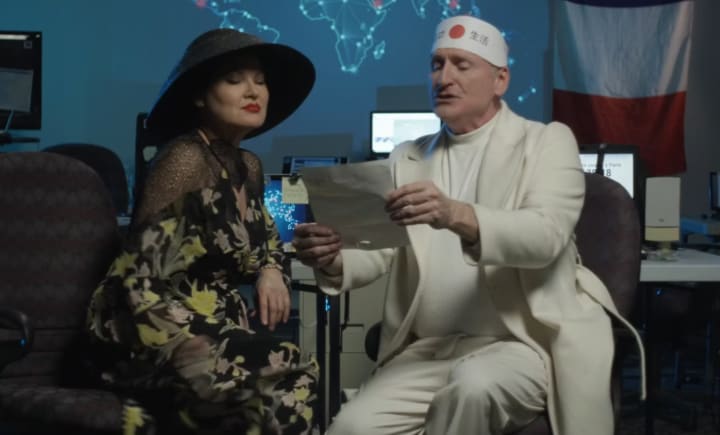How Powerful Visual Effects Were Made and A Run Down Look Of Some Powerful Film Masterpieces.
In today's edition, we talk about visual effects, classical award winning films and how films make money from the box office.

How were the visual effects achieved in the early years of cinema?
This is my favorite question because cinema is all about imagination. Nothing is real; it's all a fantasy.

At the beginning of cinema, fantasies were a very important part of the film and the stories. Even during the days of black and white films, these fantasies were an essential part of cinema. Even 100 years ago, you could see rockets landing on the moon before it happened.
Before virtual reality and video editing, there were different ways of recreating reality to create visual effects. First, they were using miniature sets to recreate reality. For example, a Russian film recreated a miniature set of a school bus that depicts it falling off a cliff, and it seemed so real on film. This was also done in Indiana Jones when they used small-scale reproduction of reality to take shots containing various visual effects.
Filmmakers would also use mirrors to create a disappearance effect on sets. One of the most beautiful visual effects I saw in a Czech movie was where the character, Waterman, would disappear into a highway of sewers to go anywhere he wanted. They placed a mirror in front of the portal sink with a waterslide behind it; the actor would then jump into the slide and disappear behind the mirror. It was great.
The greatest advancement in visual effects came with the creation of the green screen. This came in very early during black and white cinema days, but it was not very accurate. For example, in battle scenes, a gladiator's sword would suddenly disappear. Then, in the 80s, a group of filmmakers created a way to use the green screen to add interactive scenes between real actors and animations in Who Framed Roger Rabbit. It was so revolutionary that they won 4 Oscars and more than 20 other awards for what they did.

Another common technique to recreate fire scenes was to place a lighter flame next to a camera to make it appear that everything was on fire.
Hollywood was the leader in creating these techniques and visual effects. They mastered the car chase scenes by combining close-up shots, visual effects, stunts, and other film devices.
Another technique used before computer-generated effects was manipulating perspectives. The last one I remember seeing used in American Cinema was for the Christmas movie Elf, where Will Ferrell was a giant elf way bigger compared with the rest of Santa's little helpers. They played with the video perspective by filming Will Ferrell, the Elf, very close to the camera, while the rest of the set was further away from the camera. This made it seem like they were very different in size on-screen, but they would still look close to each other when watched from two dimensions. Therefore, they could act out the scene as if they were close to each other, and voila, it looked like the actor was a giant compared to the rest.
The last and notable elements used in visual effects were masks and special makeup; who can forget about Michael Jackson's wolverine eyes at the end of the Thriller?

What goes into making an instantly recognizable promotional poster for a film/movie?
In my opinion, take it or leave it, a visual artist that can give special meaning and symbols to your artwork. Whereas many filmmakers make the mistake of hiring a graphic artist, they are good at creating visual representations but not necessarily visual art. Hiring a visual artist will allow you to stand out from the others, which mostly copy the old ideas and techniques of poster design. I would not even suggest using stills from your movie, as much as you might like that idea. The stills from your movie can mean a lot to you, but to the public, they do not make the same sense. The only thing that catches the eye of the public is an artistic appeal.
Stop watching movies this way. If you nitpick a movie, then that means the film did not touch you. A movie is like an orchestra; it has to play many tunes in harmony and all together. So if one element is distinct and you have to think about it, it means that you are not being immersed into the world of the movie. To enjoy the film and admire the work of each department, it takes experience in technical roles to truly appreciate their work in what you see, feel and experience.

For example, when you listen to an orchestra or watch the role of the main character, you hear the music and listen to the emotion, letting it in similarly, you should watch the character and let their spirit in.
How do film companies collect revenue money from cinemas?
Cinemas have two types of deals with filmmakers.
In one instance, they rent their screens to filmmakers. So the cinema owner charges them expenses with a premium for cleaning, maintenance, amenities, and utilities. The filmmaker then keeps the remaining box office revenue difference as their profit. This deal is called "four walls distribution."
The other way is a revenue split share of the box office. During the first week, the cinema will keep roughly 90 percent of the revenue. Then, during the second week, the cinema will keep between 50 to 80 percent of the revenue depending on the negotiation; the remaining revenue goes to the film company.
How much input does a movie director usually have in the editing process?
All of it, 100 percent, but in today's world, most movies are not owned by the director; they are owned by the producer or production company. So the producer or head of the production company would have the final word on the movie. This is called the right to the final cut. Usually, the director is always with the visual or sound editors in the editing room during editing. They follow protocol to get the vision they want from the movie, but in the end, it's the producer that will decide what to keep or remove from the final cut of the movie.
***
Thanks to all our fans, will we see everyone next time for our expert advice?
My Wacko Parents will be available to watch directly on demand. Please check out our trailer here.

About the Creator
7 Art Distribution
Over 20 years, Seven Art Distribution has supported Independent Filmmakers by providing them a channel to bring their art to screens all around the World.






Comments
There are no comments for this story
Be the first to respond and start the conversation.